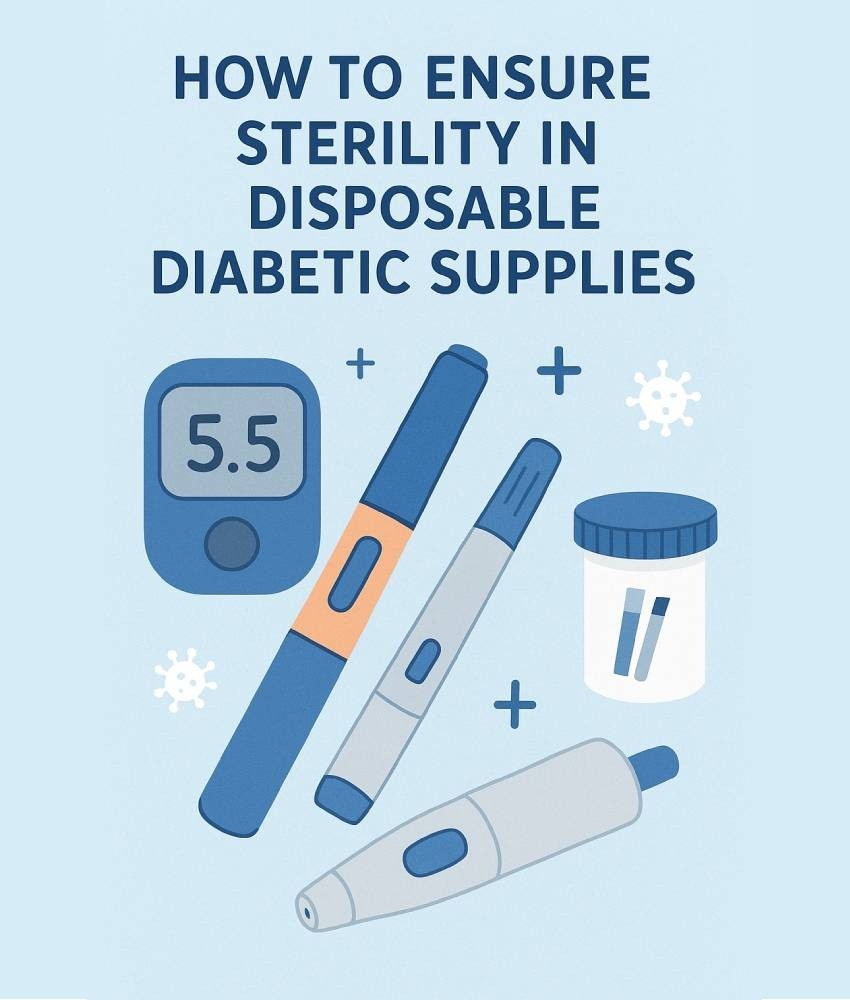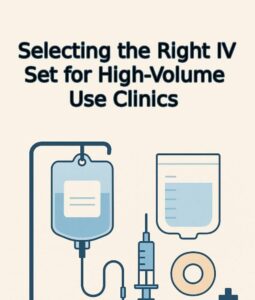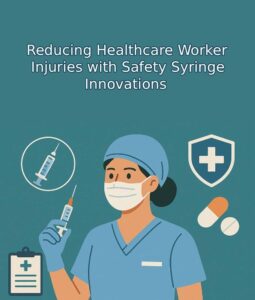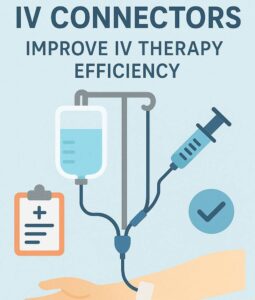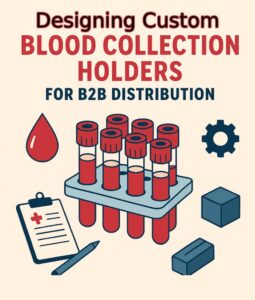Ensuring sterile diabetic supplies is a non-negotiable in the world of medical safety. Whether it’s blood glucose monitors, insulin syringes, or lancets, maintaining sterility during production, packaging, and shipping is essential to prevent infection and safeguard diabetic patients. With the global demand for EO diabetic device solutions and the rise of hygienic medical export regulations, it’s more important than ever for manufacturers and suppliers to adopt stringent sterilization and compliance practices. Know more..
Introduction: The Need for Sterility in Diabetic Products
Why Sterility Matters for Diabetics
Diabetic patients are at a higher risk of infection, particularly when using injectable or blood-interacting devices. This makes the sterility of their supplies not just a quality control concern—but a critical health issue.
Linking EO Sterilization to Safety
Among various sterilization techniques, EO diabetic device sterilization remains the gold standard. Ethylene Oxide (EO) is used because of its effectiveness in eliminating pathogens without damaging sensitive materials.
The Role of Hygienic Medical Export Standards
For global distribution, meeting hygienic medical export regulations such as ISO 13485 and FDA 21 CFR 820 ensures safe arrival and usability of products in different markets.
Understanding Sterile Diabetic Supplies
Definition and Importance
Sterile diabetic supplies refer to single-use devices that are free from all living microorganisms, ensuring they don’t introduce pathogens into the body.
Types of Diabetic Devices Requiring Sterility
- Insulin syringes
- Pen needles
- Blood glucose testing strips
- Continuous Glucose Monitoring (CGM) applicators
- Infusion sets for insulin pumps
All these require validated sterilization procedures for patient safety.
Sterilization Methods Used in Medical Manufacturing
Ethylene Oxide (EO) Sterilization
EO diabetic device processing is highly effective due to its ability to penetrate complex devices and packaging while preserving product integrity.
Gamma Radiation and Alternatives
While used for some devices, gamma radiation can compromise plastic components and isn’t ideal for all diabetic tools.
Moist Heat and Dry Heat Sterilization
These are more common in reusable devices. However, they are less frequently used in hygienic medical export due to potential material degradation.
Why EO Diabetic Device Sterilization Leads the Industry
Compatibility with Sensitive Materials
EO sterilization is compatible with materials like plastics, electronics, and adhesives—making it perfect for sterile diabetic supplies.
Low Residuals and Regulatory Acceptance
Proper EO aeration leaves behind negligible chemical residue and is approved by agencies like the FDA and EU regulators.
The EO Sterilization Process: Step-by-Step Overview
- Pre-conditioning: Devices are brought to optimal temperature and humidity to ensure even EO gas distribution.
- EO Exposure: Devices are exposed to EO gas in a sealed chamber for a specific time and concentration.
- Aeration: Devices undergo extended air flushing to remove EO residues.
- Packaging: Final packaging uses breathable barriers (e.g., Tyvek) to maintain sterility.
This process ensures hygienic medical export readiness.
Packaging and Barrier Systems for Sterile Diabetic Supplies
Tyvek and Multi-layer Films
These allow sterilizing gas to penetrate but prevent bacterial entry during shipment and storage.
Maintaining Barrier Integrity During Transport
Shock-absorbing materials and vacuum sealing maintain packaging integrity, a key for sterile diabetic supplies shipped internationally.
Quality Control Measures to Ensure Sterility
Sterility Assurance Level (SAL)
Manufacturers aim for SAL of 10⁻⁶, meaning the chance of one microorganism surviving is one in a million.
Biological Indicators and Batch Testing
Each batch includes biological indicators to validate sterility, a core part of EO diabetic device production.
Hygienic Medical Export Regulations and Compliance
ISO, FDA, and EU Standards
To achieve hygienic medical export certification, manufacturers must comply with:
- ISO 11135 for EO sterilization
- ISO 13485 for quality management
- FDA 21 CFR 820 for medical device GMP
Exporting to International Markets
Countries like Germany, Japan, and Canada require documentation of validated sterilization and batch release protocols.
Cold Chain vs Ambient Transport for Sterile Diabetic Supplies
Risk Management in Logistics
While many sterile diabetic supplies are stable at room temperature, some components (like sensors) need cold chain logistics to preserve functionality.
Temperature-Sensitive Packaging
Using thermal insulation, phase change materials, and real-time tracking ensures product safety during transit.
Labeling, Traceability, and Shelf-Life Assurance
Lot Coding and Expiration Tracking
Labeling systems must provide clear lot numbers, expiry dates, and storage conditions to meet hygienic medical export standards.
Regulatory Label Requirements
Exported supplies must include:
- Sterilization method
- Manufacturing origin
- Instructions in the destination country’s language
Sterility Failures: Risks and How to Prevent Them
Contamination Scenarios
- Incomplete EO exposure
- Faulty packaging seals
- Poor storage conditions post-sterilization
Root Cause Analysis in Production
CAPA (Corrective and Preventive Action) protocols help resolve recurring issues in EO diabetic device production lines.
Trends in Hygienic Medical Export and Global Demand
Growing Need for Diabetic Devices
The global diabetic population is expected to hit 643 million by 2030, driving demand for sterile diabetic supplies.
Top Export Destinations and Logistics Partners
High-growth regions include:
- Southeast Asia
- Latin America
- Eastern Europe
Reliable partners like DHL Medical Express and UPS Healthcare specialize in hygienic medical export logistics.
Best Practices in EO Diabetic Device Manufacturing
Facility Cleanroom Design
Sterilized zones with controlled airflow, HEPA filters, and contamination control are essential for producing EO diabetic device systems.
Staff Hygiene and Environmental Monitoring
Regular audits, gowning protocols, and microbial surface testing ensure sustained sterility.
Case Study: A Successful EO Diabetic Device Export Operation
A leading manufacturer in Singapore used EO sterilization, validated Tyvek packaging, and global logistics networks to export sterile diabetic supplies to 45 countries. Within 2 years, they reduced return rates by 60% and gained ISO 13485:2016 certification.
Choosing the Right Partner for Sterile Diabetic Supplies
Qualities of a Trusted Supplier
- EO-certified sterilization facilities
- Compliance with global regulatory frameworks
- Transparent batch testing data
How to Vet EO Sterilization Partners
- Request validation reports
- Inspect QA/QC protocols
- Conduct periodic supplier audits
Future Technologies in Diabetic Device Sterility
Smart Packaging and IoT Tracking
Smart labels and IoT sensors will soon provide real-time data on temperature, humidity, and tampering for hygienic medical export.
Sustainable Sterilization Alternatives
Research is ongoing into ozone and plasma sterilization—safer for the environment yet potentially effective for future EO diabetic device innovations.
FAQs About Sterile Diabetic Supplies and EO Sterilization
Q1: Why is EO sterilization preferred for diabetic devices?
Because it’s effective, material-safe, and approved by most global regulatory agencies.
Q2: What materials are compatible with EO?
Plastics, elastomers, electronics, adhesives, and even complex multi-component systems.
Q3: Can EO residue be harmful?
Not if aeration is properly completed. Residuals are regulated and tested per batch.
Q4: What’s the shelf-life of sterile diabetic supplies?
Typically 2–5 years, depending on packaging and storage conditions.
Q5: How can I verify a product’s sterility?
Check for validated SAL, EO sterilization markings, and compliance with ISO/FDA.
Q6: Is EO sterilization eco-friendly?
It’s effective but not the greenest; however, modern systems capture and neutralize EO gas to reduce environmental impact.
Conclusion: Building Trust Through Sterile, Compliant Exports
With millions relying on diabetic products daily, ensuring sterile diabetic supplies is more than a manufacturing requirement—it’s a moral and professional responsibility. Through precise EO diabetic device sterilization and adherence to hygienic medical export standards, manufacturers can deliver safety, trust, and global reliability with every product shipped.

